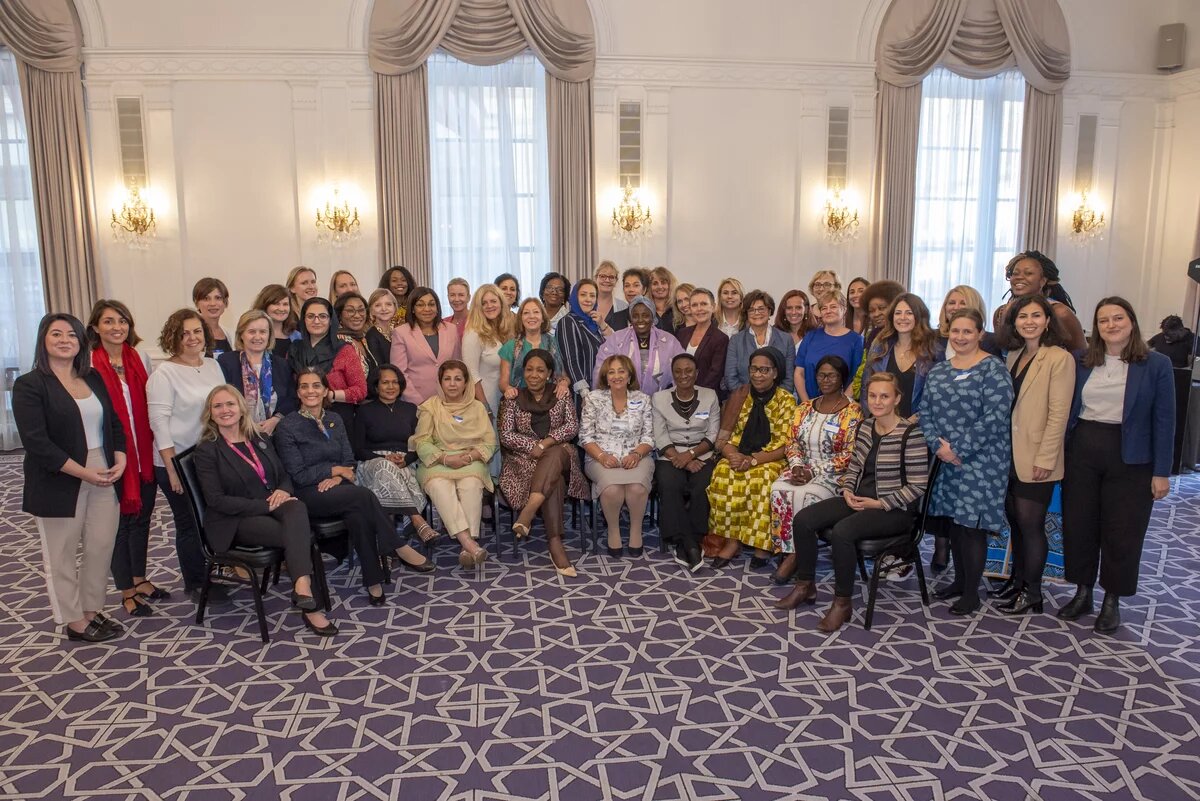Mediation plays an essential role in conflict situations worldwide. While research has shown that peace agreements are more effective when women were part of the negotiations, still only a small number of women mediators are involved in the processes.

Over the past two years, many so-called regional women mediator networks have been established across the world. Today, there is around a dozen such regional, sub-regional, and national networks that bring together women working in peace mediation. Examples include FemWise Mediation Network established by the African Union, Nordic Women Mediators, and Women Mediators Across the Commonwealth. These networks vary in their structures, formality, and mandates. Despite their differences, they all formed in response to the continued exclusion of women from peace processes with the aim of advancing the place of women in mediation. The need for these networks is real: 19 years after the adoption of the ground-breaking UN Security Council Resolution 1325, which acknowledges the crucial role women can and should play in peace processes, “women constituted only 2 per cent of mediators, 8 per cent of negotiators, and 5 per cent of witnesses and signatories in all major peace process” between 1990 and 2017.
This article explores how regional women mediator networks can help women in the field do their work better. It will look at how the new networks might bring some of the objectives of UN Security Council Resolution 1325 into being while also serving the expressed needs and interests of the networks’ diverse memberships. While regional women mediator networks can support women in several different ways, the article focuses on three specific impact areas: 1) connecting women mediators with resources and opportunities, 2) enhancing the visibility of women mediators, and 3) increasing the demand for mediation.
Mediation and tracks of dialogue
“Mediation” describes the activities of third-party interveners to bridge the divide between conflict parties. Though mediation in the context of international affairs is often thought of as a tool for conflict resolution, it can in fact be deployed at different stages of a conflict and for different purposes: It can be used at the international, regional, national, or community levels for the purpose of conflict prevention, conflict management, conflict resolution, or post-conflict transition. Mediation approaches can also be utilised in a variety of forums or so-called “tracks” (levels): formal, high-level talks between representatives of the conflict parties (Track 1); informal talks involving official representatives of the conflict parties (Track 1.5); informal talks involving non-officials who nevertheless hold positions of power or influence (Track 2); or people-to-people contact, often at the civil society and grassroots level (sometimes referred to as Track 3). Women mediator networks can support women mediators working at all levels.
Connecting members with opportunities
As a first step in helping to connect their members with opportunities, many women mediator networks offer their members access to training to upgrade or formalise their skills. This is a fundamental and welcomed form of support as it enables continued learning. Training programs are excellent incubators of skill, but they are no substitute for the first-hand experience of mediating a peace process. Not only that, but training is not nearly as emphasised in the professional development of men working in mediation. A key function of the networks will be in disrupting the dynamic that sees women mediators, in an effort to unlock access to practical experience, engage in more and more training. Effectively disrupting this tendency will require that women mediator networks advocate strategically for more opportunities for their members – opportunities where they can put their considerable training and skill into effect.
Work in this vein has been underway for some time, especially with respect to Track 1 work. It reached its first peak on September 26th, 2019, when representatives of the newly launched Global Alliance of Regional Women Mediator Networks – a network of networks – handed over a list of over thirty highly skilled and experienced women mediators to United Nations (UN) Deputy Secretary-General Amina Mohamed. This was not just a symbolic gesture. The roster reflects the members within the Global Alliance who have responded to the UN’s global call for nominations for the positions of Special Representative of the Secretary-General (SRSG) and Deputy Special Representative of the Secretary-General (DSRSG) in the United Nations Peace Operations. These women are ready and well-placed to take on leading roles in official mediation processes. No doubt, with the twenty-year anniversary of UN Security Council Resolution 1325 in 2020, there will be other such high-profile occasions for advocating for more opportunities for women mediators. It will be important that the message is carried beyond Women, Peace and Security-centric forums as well to avoid preaching to the converted.
Additionally, women mediator networks can play a role in helping to cultivate opportunities for members who are working at the Track 2 and Track 3 levels. For some members, there might be a desire to make the transition into Track 1 work. For others, however, they might prefer to continue their efforts in non-official spaces. This would likely require that the women mediator networks evolve different advocacy techniques from those described above. For example, it might entail helping members attract financial resources in support of their work since, as UN Deputy Secretary-General Amina Mohamed pointedly remarked during her speech setting out the UN’s support for women mediators, “where is the money going to come [from] to finance you? This can’t be done with fresh air.”
Enhancing visibility at all mediation levels
The example above of the Global Alliance handing off a list to UN Deputy Secretary-General Mohamed is illustrative of using a roster of women mediators paired with a high-profile event to raise the visibility of network members. This kind of approach can be enormously impactful. Not only can it work directly to help create opportunities for network members, it can also create a strong accountability mechanism for international institutions. Such approaches chip away at a familiar script regarding the shortage of qualified women that is often expressed in response to calls to improve representation. They do so by providing concrete evidence that advocates can refer to in response to claims that there just are not enough qualified women from which to choose.
As with the earlier example of creating opportunities for members, it will be important for regional women mediator networks to ensure that their approaches make sense for members working in different mediation spaces. The roster approach described above is well-suited to raising the profile of existing and would-be Track 1 women mediators when engaging institutions like the UN. It might not be as helpful to women mediators who are working at the Track 2 and Track 3 levels.
Despite the importance of the work that is being done at the Track 2 and Track 3 levels, this work often goes unrecognised. Sometimes that is on purpose: Keeping a low profile and passing on credit to the official track is often crucial for the effectiveness of Track 2 or 3 engagements. Other times, the lack of recognition is due to dismissiveness toward work that falls outside of conventional or official forums and engages non-official actors. We should pay attention to this tendency since these are the levels of engagement in which women mediators are particularly active.
Under these different circumstances, women mediator networks can develop other approaches to raise the visibility of their members in such a way that enables them to continue their work effectively at all tracks and in a way that is safe and financially sustainable for them. Women Mediators across the Commonwealth, for example, is compiling case studies of their members’ work in different peace processes, national dialogues, and community peacebuilding initiatives. These case studies profile the often innovative approaches network members have devised under extraordinarily challenging conditions. As the case studies become resources for mediation practitioners, government institutions, and others, they will indirectly serve to raise the profile of the network members.
Increasing the demand for mediation
Calling for institutions to work to increase the demand for a service they offer might sound like a nefarious case of market manipulation. To be frank, currently there is not an overwhelming demand for mediation in conflicts. And when the demand comes, it is rarely a request for women mediators in particular. Consider this in relation to the fact that there are several relatively new regional women mediator networks and one might conclude that the whole thing is headed toward an over-supply problem. This is not, however, a make-work project or a market manipulation. Mediators mediate because it is often the best possible option for the parties in conflict to bring their dispute to an end and to limit the toll the conflict takes on innocent civilians. From the perspective of the international community, supporting mediation efforts is also much less expensive than military or other forms of intervention. More conflicts – be they at the international, regional, national, or local levels – should explore solutions through mediation. Regional women mediator networks can play an advocacy role in encouraging this course.
What this would mean in practice is still unclear, but early steps in the right direction might involve networks deploying members with relevant expertise to conflict fact finding missions. On the basis of the reports that emerge, mediator networks can engage with conflict stakeholders to educate them as to what a mediation process may be able to accomplish, guide expectations more broadly, and make recommendations on a way forward.
Conclusion
This article has briefly explored some of the ways regional women mediator networks might change the landscape of peace mediation. Their activities and potential for impact are by no means restricted to the items discussed here. For example, over time, and with the necessary (mostly financial) resources, networks may build their own capacity to send mediation teams into conflict situations. Already, regional women mediator networks have taken on a formidable agenda. Success will require overcoming challenges on at least two fronts. First, networks must push back against a status quo that is plagued by, at best, benign complacency or, at worst, active opposing forces to progress towards equality and inclusivity. Second, the networks will also have to contend with the difficulties that arise in any network-based initiative: divergent interests within the membership, time constraints outside of members’ “day jobs”, elements of competition amongst members, and the management complexities endemic to such initiatives. Despite these challenges, and with the continued if not increased support of the international community, women mediator networks are well-positioned to drive significant progress in the participation of women in peacebuilding at all levels.
This article is part of our web dossier on Feminist Foreign Policy realized in collaboration with the Centre for Feminist Foreign Policy.
Further reading:
- For those who have been following developments in the field, there is a range of familiar and disappointing statistics relating to the lack of progress, if not backsliding in efforts to see women take more equal roles in such processes. For an overview of the state of affairs, please refer to: Catherine Turner, “Absent or Invisible? Women Mediators and the United Nations,” Global Policy, 9:2, May 2018.
- For a few examples of what this looks like in practice, please see “Nine Models for Inclusion of Civil Society in Peace Processes,” Inclusive Security, https://www.inclusivesecurity.org/wp-content/uploads/2013/11/9-Models-for-Inclusive-Peace-Processes-w-footers.pdf, [Accessed 3 October 2019].



